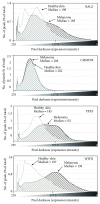WIPI1, BAG1, and PEX3 Autophagy-Related Genes Are Relevant Melanoma Markers
- PMID: 30622661
- PMCID: PMC6304818
- DOI: 10.1155/2018/1471682
WIPI1, BAG1, and PEX3 Autophagy-Related Genes Are Relevant Melanoma Markers
Abstract
ROS and oxidative stress may promote autophagy; on the other hand, autophagy may help reduce oxidative damages. According to the known interplay of ROS, autophagy, and melanoma onset, we hypothesized that autophagy-related genes (ARGs) may represent useful melanoma biomarkers. We therefore analyzed the gene and protein expression of 222 ARGs in human melanoma samples, from 5 independent expression databases (overall 572 patients). Gene expression was first evaluated in the GEO database. Forty-two genes showed extremely high ability to discriminate melanoma from nevi (63 samples) according to ROC (AUC ≥ 0.85) and Mann-Whitney (p < 0.0001) analyses. The 9 genes never related to melanoma before were then in silico validated in the IST online database. BAG1, CHMP2B, PEX3, and WIPI1 confirmed a strong differential gene expression, in 355 samples. A second-round validation performed on the Human Protein Atlas database showed strong differential protein expression for BAG1, PEX3, and WIPI1 in melanoma vs control samples, according to the image analysis of 80 human histological sections. WIPI1 gene expression also showed a significant prognostic value (p < 0.0001) according to 102 melanoma patients' survival data. We finally addressed in Oncomine database whether WIPI1 overexpression is melanoma-specific. Within more than 20 cancer types, the most relevant WIPI1 expression change (p = 0.00002; fold change = 3.1) was observed in melanoma. Molecular/functional relationships of the investigated molecules with melanoma and their molecular/functional network were analyzed via Chilibot software, STRING analysis, and gene ontology enrichment analysis. We conclude that WIPI1 (AUC = 0.99), BAG1 (AUC = 1), and PEX3 (AUC = 0.93) are relevant novel melanoma markers at both gene and protein levels.
Figures





References
MeSH terms
Substances
LinkOut - more resources
Full Text Sources
Medical

